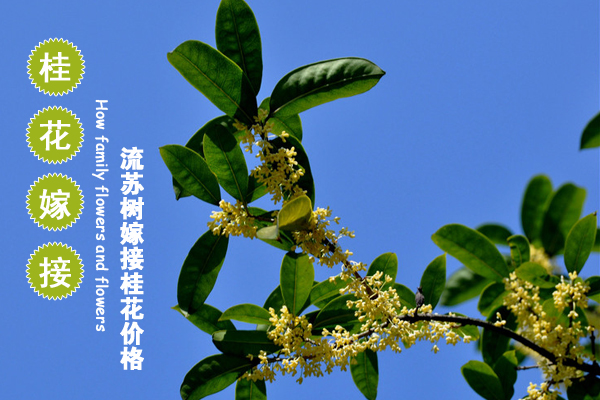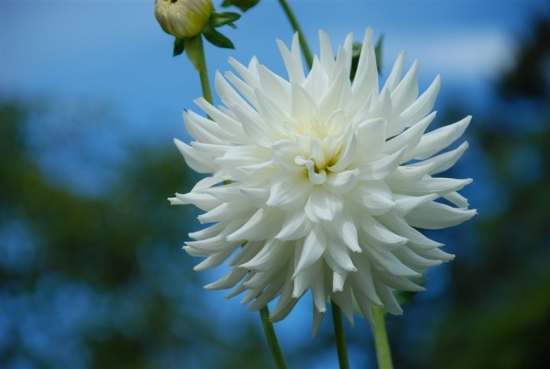Why don't sweet-scented osmanthus trees bloom?
Why don't sweet-scented osmanthus trees bloom? The main reason for the failure of home-grown osmanthus to blossom: when ① was transplanted, too many roots were hurt, and the vitality was not fully restored, resulting in poor growth and no flowering. The soil planted in ② should be loose and acidic and should be planted in a high dry place with good drainage. If planted in low-lying areas, it will grow poorly and it will be difficult to blossom. There is a lot of bituminous coal dust or carbon dioxide and other air pollution in the environment around ③, which makes it difficult for sweet-scented osmanthus to bloom. In order to make sweet-scented osmanthus blossom more and more, we need to grasp the following links:
The main results are as follows: (1) to select slightly acidic soil: 5 parts of mountain mud, 3 parts of humus soil and 2 parts of sandy soil can be selected in pot culture, or rotten leaf soil and sandy loam soil can be used as culture soil. If the soil acidity is too strong, the growth is slow, the leaves are yellow and the leaves are withered. In alkaline soil, it can lead to leaf withering and even death after 2-3 months.
(2) watering should be timely: sweet-scented osmanthus watering should be "two less and one more", that is, less watering before the occurrence of new shoots, less watering in rainy days, and more watering in dry weather in summer and autumn. Usually watering is appropriate to keep the water content of the basin soil about 50%. Drainage should be timely on cloudy and rainy days to prevent stagnant water in the basin from rotting roots.

In winter, many plants are dormant because of low temperatures and do not begin to grow until the next year. And sweet-scented osmanthus will also encounter this problem in the process of breeding. If its temperature is relatively high in winter, there is no way to get good dormancy, and it will consume a lot of nutrients prematurely. So that in the second year, there is no way to adapt to the environment, resulting in withering, or even withering.
2. Why don't sweet-scented osmanthus trees blossom-- too shady?
Sweet-scented osmanthus has higher requirements for breeding environment and higher requirements for light. It likes strong light and belongs to sunshine plants, so it can get a good growth environment if it is placed in a place with plenty of light. If there is not enough light, it will have a large number of fallen leaves, which will affect the formation of flower buds.
3. Why don't sweet-scented osmanthus trees blossom-- the influence of soot
Sweet-scented osmanthus trees are not resistant to smoke and dust, and the environment in which we live has heavy smoke and serious air pollution, which is often not conducive to the growth of sweet-scented osmanthus. Therefore, it is recommended to put it in a place with a good air environment, which is conducive to its growth, will also make the leaves thrive and let the flowers bloom more and better.
4. Why don't sweet-scented osmanthus trees bloom-- lack of nutrients
The nutrients of any kind of plant are very important, then sweet-scented osmanthus is no exception. If we do not give it enough nutrients, its root system will not be able to stretch well. Just like us humans, undernourished people will be more likely to get sick. If it is not healthy, it will not produce beautiful flowers.
5. Why don't sweet-scented osmanthus trees blossom-- overwatering
Although sweet-scented osmanthus needs water, but the amount of water has certain requirements, it does not like stagnant water. If you overwater or encounter continuous rain, there will be rotten roots and fallen leaves, and flowers will not grow naturally.
Why don't sweet-scented osmanthus trees bloom? There are many reasons that affect it, including soil, the water and nutrients it should be given during the growth and development period need soil to help absorb, its quality will directly affect the growth of sweet-scented osmanthus.
Red Star Macron Furniture Mall Dewey wardrobe polished Brick Map Fansha Sanitary Ware Price toto Smart toilet Price Gabriel floor Lankaway Furniture Kitchen Shelf Decoration Picture Boloni cabinets dressing Mirror tatami Price
Why don't sweet-scented osmanthus trees bloom?
Sweet-scented osmanthus trees can tolerate shade and are bright green in color, so they are suitable for growing when the sun is not enough. Sweet-scented osmanthus trees take a long time to grow, but they may not blossom. So why don't sweet-scented osmanthus trees blossom? Let's find out why sweet-scented osmanthus trees don't blossom.
Why don't sweet-scented osmanthus trees bloom?
The reasons why sweet-scented osmanthus trees do not blossom are as follows:
Smoke and dust pollution in recent years, some reports think that the leaves of sweet-scented osmanthus trees have strong resistance to sulfur dioxide, hydrogen fluoride, chlorine and other polluting gases, so sweet-scented osmanthus trees are planted in many urban parks. But in fact, because the sweet-scented osmanthus tree is native to the mountain area of the environmental scene, its growth conditions require clean air. In the air containing smoke and dust, although it may not necessarily cause damage to the leaves, it is enough to inhibit its normal flowering. Sweet-scented osmanthus tree is a kind of tree species that is not polluted by smoke and dust, so it is not suitable to be planted in places with dense factories.
In addition, on the side of the road with a large number of vehicles, it often affects the blooming of sweet-scented osmanthus trees because of the serious traffic dust.
Soil conditions are not suitable for the growth of sweet-scented osmanthus trees. Sweet-scented osmanthus trees are native to the acidic soil areas in southern China, such as Suzhou, Hangzhou, Guilin and so on. The soil is acidic or weakly acidic, and the pH value is about 5.6 ~ 6.8. However, the soil in some gardens in the city is alkaline due to the long-term influence of industrial dust, construction waste and human feces and urine. Therefore, sweet-scented osmanthus trees do not grow well in areas with high salinity in alkaline soil (such as coastal areas), and those who can blossom are even less.
Sweet-scented osmanthus trees are native to mountainous areas, which require soft soil and good drainage, but many cities have flat terrain and poor drainage, and some have a high groundwater level (such as only 0.5 meters in Shanghai), resulting in poor root development of sweet-scented osmanthus trees. Good drainage is an important condition for the growth of Osmanthus fragrans.
During improper maintenance and management, the root system and soil blocks carried by transplant are not well protected, or the aboveground branches and leaves are lack of proper pruning, resulting in the imbalance of physiological balance between underground roots and aboveground branches and leaves, as well as improper maintenance and management after planting.
Osmanthus fragrans is a slow-growing positive tree species. When mixed with other tree species, it is easy to be shaded by nearby fast-growing trees. According to the regulation, the crown of sweet-scented osmanthus can hardly blossom normally, especially when it is covered by other tree species to the south. Only in places where there is plenty of light can the pronunciation grow mysteriously. However, sweet-scented osmanthus trees can not stand long-term hot sun exposure and drought. we have seen more than once that during high temperatures in summer, especially in gardens with more cement floors, sweet-scented osmanthus trees often have abnormal mother leaves, causing the trees to retreat and cannot blossom. Although sweet-scented osmanthus trees are distributed in tropical areas, such as Hainan Island, Taiwan and Lingnan, their growth and mother are far less than those in subtropical areas, indicating that sweet-scented osmanthus trees have relatively strict requirements on climatic conditions.
Because some chewable mouthparts pests such as stinging ammonium and pocket moth do not like to eat the leaves of sweet-scented osmanthus trees, and they are easy to control, some people mistakenly think that they do not need to pay special attention to the diseases and insect pests of sweet-scented osmanthus trees, but this is not the case. It is true that the death of the whole sweet-scented osmanthus tree due to diseases and insect pests is very rare, but there are several diseases and insect pests that can endanger the flowering of sweet-scented osmanthus trees. Small and unnoticed pests such as red spiders, whiteflies, shell insects and military insects often make sweet-scented osmanthus trees yellowing and weakening their growth, especially in poorly ventilated, shaded and humid places. In addition, in the location of local water retention, the root system of sweet-scented osmanthus tree is easy to be damaged by some facultative parasites such as Fusarium oxysporum, resulting in root rot. These diseases and insects can inhibit the flowering of sweet-scented osmanthus trees, but they are often ignored by people.
- Prev

What tree can be grafted with sweet-scented osmanthus
What kind of tree can be grafted sweet-scented osmanthus? the rootstocks that can be used to graft sweet-scented osmanthus are lobular privet, big-leaf privet, water wax, white wax and sweet-scented osmanthus sowing seedlings or cutting seedlings and so on. (1) leaflet privet: deciduous or semi-evergreen shrub, 2-3 m tall, branches scattered branchlets pubescent
- Next

Which kinds of flower reproduction are there?
The methods of flower reproduction can be divided into four categories: sexual reproduction, asexual reproduction, unisexual reproduction and tissue culture reproduction. Sexual reproduction is also called seed reproduction. It is through the role of the female and male organs of the flower, that is, the combination of pollen and ovules to form seeds, which are used to reproduce. The roots of seedlings produced by seeds are strong.
Related
- Fuxing push coffee new agricultural production and marketing class: lack of small-scale processing plants
- Jujube rice field leisure farm deep ploughing Yilan for five years to create a space for organic food and play
- Nongyu Farm-A trial of organic papaya for brave women with advanced technology
- Four points for attention in the prevention and control of diseases and insect pests of edible fungi
- How to add nutrient solution to Edible Fungi
- Is there any good way to control edible fungus mites?
- Open Inoculation Technology of Edible Fungi
- Is there any clever way to use fertilizer for edible fungus in winter?
- What agents are used to kill the pathogens of edible fungi in the mushroom shed?
- Rapid drying of Edible Fungi

